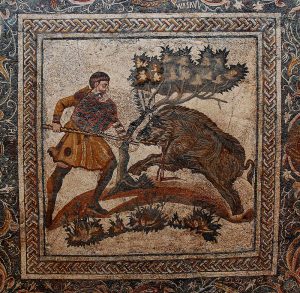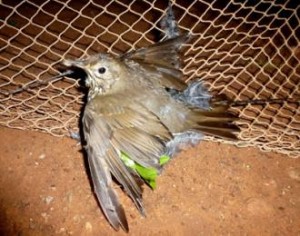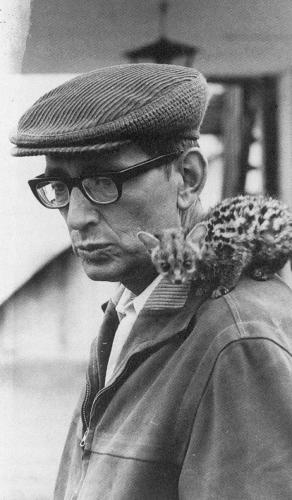Archive for the ‘hunting in Spain’ Category
Monday, December 5th, 2016

The number of registered hunters in Spain as of 2015 was 333,000, a fall of 24% in 5 years, a trend that has continued for the last 30 years. And those that still still hunt do so less. Rural depopulation is clearly a factor though I suspect the biggest reason is that the rural youth are losing interest as there are just more things to do today. El País.
I had a student a few years back whose father ran a farm some 70km to the north of Barcelona. Although Pere’s father stopped hunting many years ago, most of Josep’s friends still hunted – mainly wild boar, but none of their children – Pere included – had taken up the pastime. My partner Mónica also pointed out that many younger women are no longer prepared to do all the back work, that which never gets mentioned, involved after hunting such as skinning the hares and plucking the partridges.
Image of wild boar hunt from a Roman mosiac found in Mérida [Mosaico de Las Tiendas (MNAR Mérida)]
Posted in hunting in Spain, Traditional activities |
Wednesday, April 23rd, 2014
 Sometimes it is hard to know what to write. I want to write about positive things and I want to show people what an amazing country I have chosen to make my home. I have many friends that work hard to protect the stunning place that is called Iberia. However, sometimes I am left speechless with a writers block that I fear will never become unstuck… Even though the press release from The Committee Against Bird Slaughter is (CABS) is over a year old I have spoken to a few people living in the Valencia area and they tell me that the practice of bird trapping with glue continues as normal… My mind will become unstuck and soon I will write again. the birds caught in these awful traps I am afraid have a different fate waiting for them.
Sometimes it is hard to know what to write. I want to write about positive things and I want to show people what an amazing country I have chosen to make my home. I have many friends that work hard to protect the stunning place that is called Iberia. However, sometimes I am left speechless with a writers block that I fear will never become unstuck… Even though the press release from The Committee Against Bird Slaughter is (CABS) is over a year old I have spoken to a few people living in the Valencia area and they tell me that the practice of bird trapping with glue continues as normal… My mind will become unstuck and soon I will write again. the birds caught in these awful traps I am afraid have a different fate waiting for them.
For the first time ever CABS volunteers have managed to film the massacre with low-light cameras. “The material demonstrates that thousands of wild birds are cruelly killed and that numerous protected and endangered species are among the victims” states CABS President Heinz Schwarze. The video shows Thrushes and Blackcaps loudly and in panic fighting for their lives among the corpses of the conspecifics.
The website about this subject can be found here and you will see a link at the bottom of that page to sign a letter to be sent to the authorities… Do it now please?
And of course the subject can be discussed over at the Iberianature Forum
Thanks.
Posted in Conservation, Endangered species, hunting in Spain, Traditional activities |
Tuesday, April 8th, 2014
 The governing Partido Popular party of Spain have called for a national census of the Iberian wolf which is about time too as the last reliable census was taken in 1988. The Government will create an updated population census on the Iberian peninsular but presumably this won’t include Portugal. This census will then help to implement a national strategy for the conservation and management of the Iberian wolf and would serve as a key instrument for the conservation and efficient management of the species.
The governing Partido Popular party of Spain have called for a national census of the Iberian wolf which is about time too as the last reliable census was taken in 1988. The Government will create an updated population census on the Iberian peninsular but presumably this won’t include Portugal. This census will then help to implement a national strategy for the conservation and management of the Iberian wolf and would serve as a key instrument for the conservation and efficient management of the species.
There are claims that some of the major regions with populations of wolf have conflicting management plans For example, the Iberian wolf is a game species north of the Duero, Castilla y León and Galicia But in Asturias sport hunting for this species is not allowed. Sport hunting no but “control” yes. On the 21st of August 2013 “Matley” a wolf that was fitted with a transmitter and part of a scientific monitoring project was “controlled”
“We believe that there should be detailed studies on the status of the wolf in Spain and it’s coexistence with other species and this information will help to avoid unwarranted persecution and also to allow better coordination of conservation plans across the country.”
Here is an (outdated but good information page on the Iberian Wolf)
Here is the article on the subject in Spanish
And of course the Wolf topic over at Iberianature Forum…
Posted in Conservation, External links, hunting in Spain, Wolves |
Friday, March 21st, 2014
 With the latest news coming from Zamora that includes a Spanish Imperial eagle, amongst other carrion birds, killed from the consequences of poisoning, I thought I’d have a search around the net for similar news and information.
With the latest news coming from Zamora that includes a Spanish Imperial eagle, amongst other carrion birds, killed from the consequences of poisoning, I thought I’d have a search around the net for similar news and information.
The Vulture Conservation Council has an interesting page explaining the use of poisons that has affected Spanish Vultures.
A large number of vulture deaths in Europe can be attributed every year to poisoning, arguably the most important threat impacting on vultures today. Figures from Spain are illustrative – data from the Spanish ministry of agriculture show that between the years 2000 and 2010 a total of 40 bearded vultures, 638 black vultures, 348 Egyptian vultures and 2,146 griffon vultures were found poisoned. (The recent extinction of the bearded vulture in the Balkan Peninsula was largely due to extensive poisoning campaigns against wolves and jackals.) (more…)
Tags:bearded vulture, Griffon Vultures, misuse of poison, poisoning wildlife
Posted in birds, Conservation, Environment, hunting in Spain, Vultures in Spain |
Sunday, March 14th, 2010

The great Spanish author Miguel Delibes died on Friday 12 March. His love of the rural life and landscape of Castilla and hunting surfaced repeatedly in his books.
He won the Spanish-speaking world’s top literary award, the Premio Cervantes in 1993, along with the Premio Príncipe de Asturias de las Letras, and was a member of the Spanish Royal Academy. The Cervantes Institute said Delibes’ passion for the countryside — and hunting — had given him a true feel for the decline of rural life and the fragility of the environment. “It is not going too far to say that this hunter who writes measures his passions with a shotgun resting on his shoulder, and in this he finds joy, anxieties and even fineness of spirit,” the institute said in a biography of Delibes.
TP notes on the forum
“The recurring theme of his works was social injustice and the contrast between rural life and modernity. His ability to portray the harshness of rural life in Castilla and the language of its people was amazing. Many of his novels deal with hunting – deeply rooted in Castilla – and his famous essay justifying his love of hunting, “La caza: mi punto de vista” , and in which he vehemently criticises the mass slaughter of captive pieces, which will undoubtedly strike a chord among some iberianatureforumers, expresses very well the sentiment of many people, hunters and critics alike.”
(more…)
Tags:biography of Delibes, Castilian landscape, Cervantes Institute Delibes, Miguel Delibes
Posted in Castilla y León, hunting in Spain, nature and landscape, Spanish literature |
Tuesday, January 5th, 2010

A new study by Sergi Garcia (who I do wildlife trips with) and Antonio Navarro has found that wolf tourism has become far more economic than wolf hunting in the Sierra de la Culebra. The study, presented at the Sociedad Española para la Conservación y el Estudio de los Mamíferos, simply adds up the earnings from both sectors . Earnings from wolf tourism (hotels, restaurants, varous purchases), brings in a remarkable 500,000 euros a year compared to 150.000 euros for all forms of hunting (including deer). ” Rural lodgings have increased from just 2 in 2002 to 15 in 2009. However, the study warns against the massification of tourism in the area and criticises the new wolf visitor’s centre to be opened this year in Sanabria.
More here (Estimación del impacto económico del turismo lobero en la Sierra de la Culebra).
News and photo from La Crónica Verde
Tags:Sergi Garcia, wolf hunting in Spain
Posted in Castilla y León, hunting in Spain, Mammals, Wolves |
Tuesday, January 13th, 2009

The new wolf hunting management plan in Castilla y León is alarming Spanish conservationists. The price for shooting a wolf in Castilla y León is set at 3000 euros, though many more are also killied illegally, some of which because of an increasing interest among illegal hunting rings under the tacit protection of the regional government. If you can get Spanish television, Informe Semanal is to show a report on the issue on 17th January.
- Fapas
- EU to accept wolf hunting (IbNat) “Some 200 wolves are hunted legally every year in Spain, and many more illegally, not just in Castilla-Leon but also in Asturias where 25 wolves were killed between January 2006 and March 2007, by officials after reports of sheep deaths. In contrast, in the Sierra de la Culebra, rich hunters pay up to 18,000 euros to kill a wolf.”
Above photo: Two wolves killed illegally in Valladolid in 2006. (El Pais). The agents seems to have taken pleasure in displaying theire capture.
Tags:illegal wolf hunting
Posted in Castilla y León, hunting in Spain, Mammals, On Spain, Wolves |
Sunday, January 4th, 2009
Poison is killing Spanish wildlife, it’s official. According to a study carried out by Ecotoxicología, with figures confirmed by the government, the number of dead animals found is only the tip of the iceberg. The study has revealed that in the last 15 years almost 7,000 animals included in the National Catalogue of Endangered Species have perished even though the practice of setting poisoned bait in the countryside has been banned since 1983. In general terms of species affected, the bodies recovered account for only between 5% and 15% of the estimated total of deaths due to poison. The author of the study and director of a forensic wildlife laboratory, one of six such centres in Spain, Mauro Hernández says the figures represent the minimum amount of casualties. Every year at least 800 animals are admitted to his laboratory alone. In the case of the Spanish Imperial eagle, the study believes that for every bird found poisoned another possible nine could be undetected. The problem is proving a stumbling block for many recovery and reintroduction programmes.
The method of setting meat laced with poison is aimed at predators in competition with man such as foxes and wolves but is indiscriminate in its killing. Even a small quantity ingested can weaken an animal and leave it vulnerable to death by other means such as collision with traffic or overhead power cables, or drowning because one of the effects of the poisons most commonly used is severe thirst. Most recent cases have been the discoveries of a Lammergeier and an Iberian lynx, both in Andalucia.
As in a previous study by WWF/Adena, “Poison in Spain, 1990-2005“, the blame is mainly directed at a small proportion of the hunting and farming communities, the administrations of which are both trying to combat the problem from within. Temporary closure of hunting reserves where poison has been discovered has been found to be insufficient but stricter penalties should help. Two hunters were recently succesfully prosecuted and sentenced to two years in prison for setting poisoned bait on a hunting estate in Lérida, Catalunya. To supplement the national SOS Poison hotline campaign, a network of predator control managers is to be established. Let’s hope that tighter regulations on the selling of the noxious substances follow.
Tags:bait, Black Vulture Conservation Foundation, Ecotoxicología, misuse of poison, number of animals killed by poison, poison, poison and predator control, poisoning wildlife, SOS Veneno, use of poison in Spain
Posted in Farming, hunting in Spain, Rural Spain |

 Sometimes it is hard to know what to write. I want to write about positive things and I want to show people what an amazing country I have chosen to make my home. I have many friends that work hard to protect the stunning place that is called Iberia. However, sometimes I am left speechless with a writers block that I fear will never become unstuck… Even though the press release from The Committee Against Bird Slaughter is (CABS) is over a year old I have spoken to a few people living in the Valencia area and they tell me that the practice of bird trapping with glue continues as normal… My mind will become unstuck and soon I will write again. the birds caught in these awful traps I am afraid have a different fate waiting for them.
Sometimes it is hard to know what to write. I want to write about positive things and I want to show people what an amazing country I have chosen to make my home. I have many friends that work hard to protect the stunning place that is called Iberia. However, sometimes I am left speechless with a writers block that I fear will never become unstuck… Even though the press release from The Committee Against Bird Slaughter is (CABS) is over a year old I have spoken to a few people living in the Valencia area and they tell me that the practice of bird trapping with glue continues as normal… My mind will become unstuck and soon I will write again. the birds caught in these awful traps I am afraid have a different fate waiting for them.


